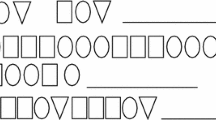Abstract
This paper describes kindergarten children’s engagement with two patterning activities. The first activity includes two tasks in which children are asked to choose possible ways for extending two different repeating patterns and the second activity calls for comparing different pairs of repeating patterns. Children’s recognition of the unit of repeat and their recognition of the structure of the repeating patterns are investigated. Findings suggest differences between children’s responses to patterns that end with a complete unit of repeat and those that end with a partial unit. In addition, the issue of presenting repeating patterns using different media is discussed.



Similar content being viewed by others
Notes
In our study, kindergarten refers to children between the ages of 5–6 years old scheduled to enter first grade in the following school year. However, when referring to other studies, we adopt the terminology (e.g., preschool or kindergarten) that is used in the original study.
All patterns appear in color on the online version of this paper.
References
Bäckman, K. (2016). Children’s play as a starting point for teaching shapes and patterns in the preschool. In T. Meaney, O. Helenius, M. L. Johansson, T. Lange, & A. Wernberg (Eds.), Mathematics education in the early years – Results from the POEM2 Conference (pp. 223–234). New York: Springer International Publishing.
Björklund, C. (2016). Playing with patterns: Conclusions from a learning study with toddlers. In T. Meaney, O. Helenius, M. L. Johansson, T. Lange, & A. Wernberg (Eds.), Mathematics education in the early years – Results from the POEM2 Conference (pp. 269–288). New York: Springer International Publishing.
English, L. D., & Warren, E. A. (1998). Introducing the variable through pattern exploration. Mathematics Teacher, 91(2), 166–170.
Fox, J. (2005). Child-initiated mathematical patterning in the pre-compulsory years. In H. L. Chick & J. L. Vincent (Eds.), Proceedings of the 29th Conference of the International Group for the Psychology of mathematics education (Vol. 2, pp. 313–320). Melbourne, Australia: PME.
Greenes, C., Ginsburg, H. P., & Balfanz, R. (2004). Big math for little kids. Early Child Research Quarterly, 19(1), 159–166.
Guez-Sandler, L. (2010). Identifying repeating patterns at preschool (Unpublished master’s thesis). Tel Aviv University, Tel Aviv, Israel.
Papic, M., Mulligan, J., & Mitchelmore, M. (2011). Assessing the development of preschoolers' mathematical patterning. Journal for Research in Mathematics Education, 42(3), 237–269.
Rittle-Johnson, B., Fyfe, E. R., McLean, L. E., & McEldoon, K. L. (2013). Emerging understanding of patterning in 4-year-olds. Journal of Cognition and Development, 14(3), 376–396.
Sarama, J., & Clements, D. (2009). Early childhood mathematics education research: Learning trajectories for young children. London, England: Routledge.
Schoenfeld, A. H. (1992). Learning to think mathematically: Problem solving, metacognition, and sense-making in mathematics. In D. Grouws (Ed.), Handbook of research on mathematics teaching and learning (pp. 334–370). New York: Macmillan.
Starkey, P., Klein, A., & Wakeley, A. (2004). Enhancing young children’s mathematical knowledge through a pre-kindergarten mathematics intervention. Early Child Research Quarterly, 19(1), 99–120.
Steen, L. A. (1988). The science of patterns. Science, 24, 611–616.
Swodboda, E. (2010). Natural differentiation in a pattern environment (4 year old children make patterns). In V. Durand-Guerrier, S. Soury-Lavergne, & F. Arzarello (Eds.), Proceedings of the sixth congress of the European Society for Research in mathematics education (pp. 2657–2666). Lyon, France: Institut national de recherche Pedagogique.
Waters, J. (2004). Mathematical patterning in early childhood settings. In I. Putt & M. McLean (Eds.), Mathematics education for the third millennium (pp. 565–572). Townsville: Mathematics Education Research Group of Australia.
Watson, A., & Mason, J. (2006). Seeing an exercise as a single mathematical object: Using variation to structure sense-making. Mathematical Thinking and Learning, 8(2), 91–111.
Zazkis, R., & Liljedahl, P. (2002). Generalization of patterns: The tension between algebraic thinking and algebraic notation. Educational Studies in Mathematics, 49(3), 379–402.
Acknowledgements
This research was supported by The Israel Science Foundation (grant No. 1270/14).
Author information
Authors and Affiliations
Corresponding author
Rights and permissions
About this article
Cite this article
Tsamir, P., Tirosh, D., Levenson, E.S. et al. Repeating patterns in kindergarten: findings from children’s enactments of two activities. Educ Stud Math 96, 83–99 (2017). https://doi.org/10.1007/s10649-017-9762-7
Published:
Issue Date:
DOI: https://doi.org/10.1007/s10649-017-9762-7




